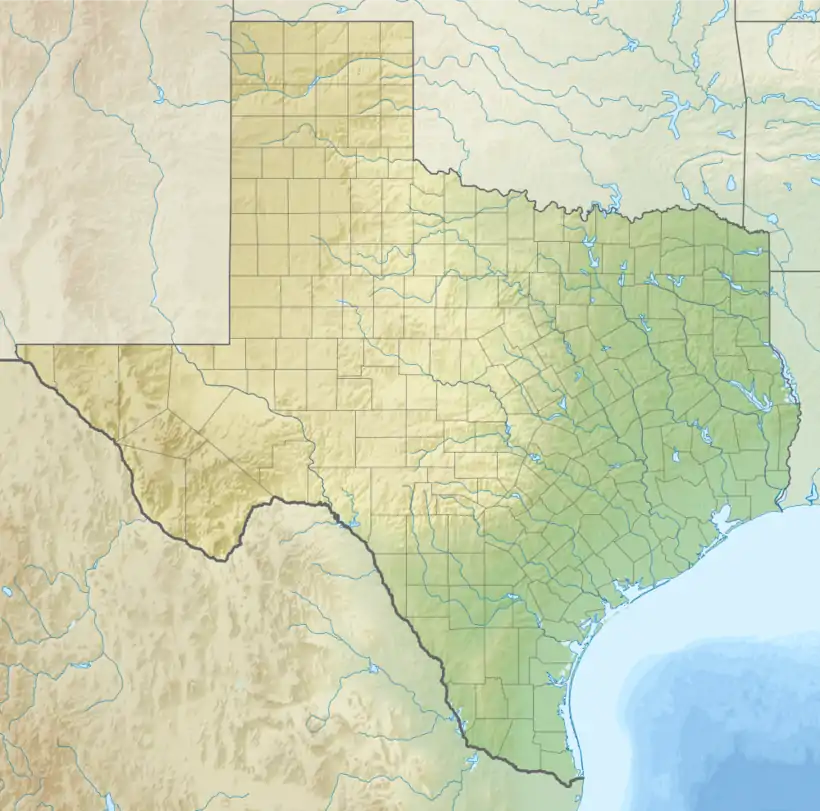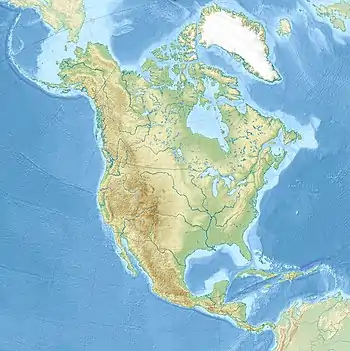Hannold Hill Formation
The Hannold Hill Formation is an Early Eocene (Wasatchian) geologic unit in the western United States.[1] It preserves the fossilized remains of the ray Myliobatis and gar.[2]
| Hannold Hill Formation Stratigraphic range: Wasatchian 55.8–50 Ma | |
|---|---|
| Type | Geological formation |
| Unit of | Big Bend Group |
| Location | |
| Coordinates | 29.4°N 103.1°W |
| Approximate paleocoordinates | 33.7°N 89.0°W |
| Region | Texas |
| Country | |
| Type section | |
| Named for | Hannold Hill |
 Hannold Hill Formation (the United States)  Hannold Hill Formation (Texas) | |
Fossil content
The following fossils have been reported from the formation:[1]
- Glires
- Pantodonta
- Caenolambda jepseni[3]
- Coryphodon armatus[4]
- Coryphodon sp.[5]
- Perissodactyla
- Hyracotherium vasacciense
- Minippus index[4]
- Placentalia
- Primates
- Phenacolemurinae indet.[4]
Wasatchian correlations
| Formation | Wasatch | DeBeque | Claron | Indian Meadows | Pass Peak | Tatman | Willwood | Golden Valley | Coldwater | Allenby | Kamloops | Ootsa Lake | Margaret | Nanjemoy | Hatchetigbee | Tetas de Cabra | Hannold Hill | Coalmont | Cuchara | Galisteo | San Jose | Ypresian (IUCS) • Itaboraian (SALMA) Bumbanian (ALMA) • Mangaorapan (NZ) |
|---|---|---|---|---|---|---|---|---|---|---|---|---|---|---|---|---|---|---|---|---|---|---|
| Basin | Powder River Uinta Piceance Colorado Plateau Wind River Green River Bighorn | Piceance | Colorado Plateau | Wind River | Green River | Bighorn | Williston | Okanagan | Princeton | Buck Creek | Nechako | Sverdrup | Potomac | GoM | Laguna Salada | Rio Grande | North Park | Raton | Galisteo | San Juan | ||
| Country | ||||||||||||||||||||||
| Copelemur | ||||||||||||||||||||||
| Coryphodon | ||||||||||||||||||||||
| Diacodexis | ||||||||||||||||||||||
| Homogalax | ||||||||||||||||||||||
| Oxyaena | ||||||||||||||||||||||
| Paramys | ||||||||||||||||||||||
| Primates | ||||||||||||||||||||||
| Birds | ||||||||||||||||||||||
| Reptiles | ||||||||||||||||||||||
| Fish | ||||||||||||||||||||||
| Insects | ||||||||||||||||||||||
| Flora | ||||||||||||||||||||||
| Environments | Alluvial-fluvio-lacustrine | Fluvial | Fluvial | Fluvio-lacustrine | Fluvial | Lacustrine | Fluvio-lacustrine | Deltaic-paludal | Shallow marine | Fluvial | Shallow marine | Fluvial | Fluvial | |||||||||
| Volcanic | Yes | No | Yes | No | Yes | No | Yes | No | Yes | No | ||||||||||||
References
- Hannold Hill Formation at Fossilworks.org
- "Big Bend National Park," Hunt, Santucci, and Kenworthy, 2006, p.66
- Lucas, 1998
- Alroy, 2002
- Wilson, 1967
Bibliography
- Hunt, ReBecca K., Vincent L. Santucci and Jason Kenworthy. 2006. "A preliminary inventory of fossil fish from National Park Service units." in S.G. Lucas, J.A. Spielmann, P.M. Hester, J.P. Kenworthy, and V.L. Santucci (ed.s), Fossils from Federal Lands. New Mexico Museum of Natural History and Science Bulletin 34, pp. 63–69
- Alroy, J. 2002. Synonymies and reidentifications of North American fossil mammals, .. _.
- Lucas, S. G. 1989. Coryphodon (Mammalia, Pantodonta) from the Hannold Hill Formation, Eocene of Trans-Pecos Texas. Pearce-Sellards Series 46. ..
- J. A. Schiebout and Et al. 1987. Stratigraphy of the Cretaceous-Tertiary and Paleocene-Eocene Transition Rocks of Big Bend National Park, Texas . Journal of Geology 95
- J. A. Wilson. 1967. Early Tertiary mammals. In R. A. Maxwell, J. T. Lonsdale, R. T. Hazzard, & J. A. Wilson (eds.), Geology of Big Bend National Park, Brewster County, Texas. The University of Texas Publication 6711:157-169
This article is issued from Wikipedia. The text is licensed under Creative Commons - Attribution - Sharealike. Additional terms may apply for the media files.
